
In cycling especially endurance and stage-race contexts electrolytes serve as the engine’s control net. They govern hydration, muscle function, nerve signaling, and energy metabolism. Without them, cyclists risk cramps, fatigue, impaired cognitive and physical performance, and even life-threatening hyponatremia or dehydration. This article offers a deep dive into why electrolytes are essential, how to replenish them smartly and safely, and how to personalize strategies for optimal performance and health. Learn More Boost Your Performance with Proper Hydration Strategies
The Science of Electrolytes and Hydration
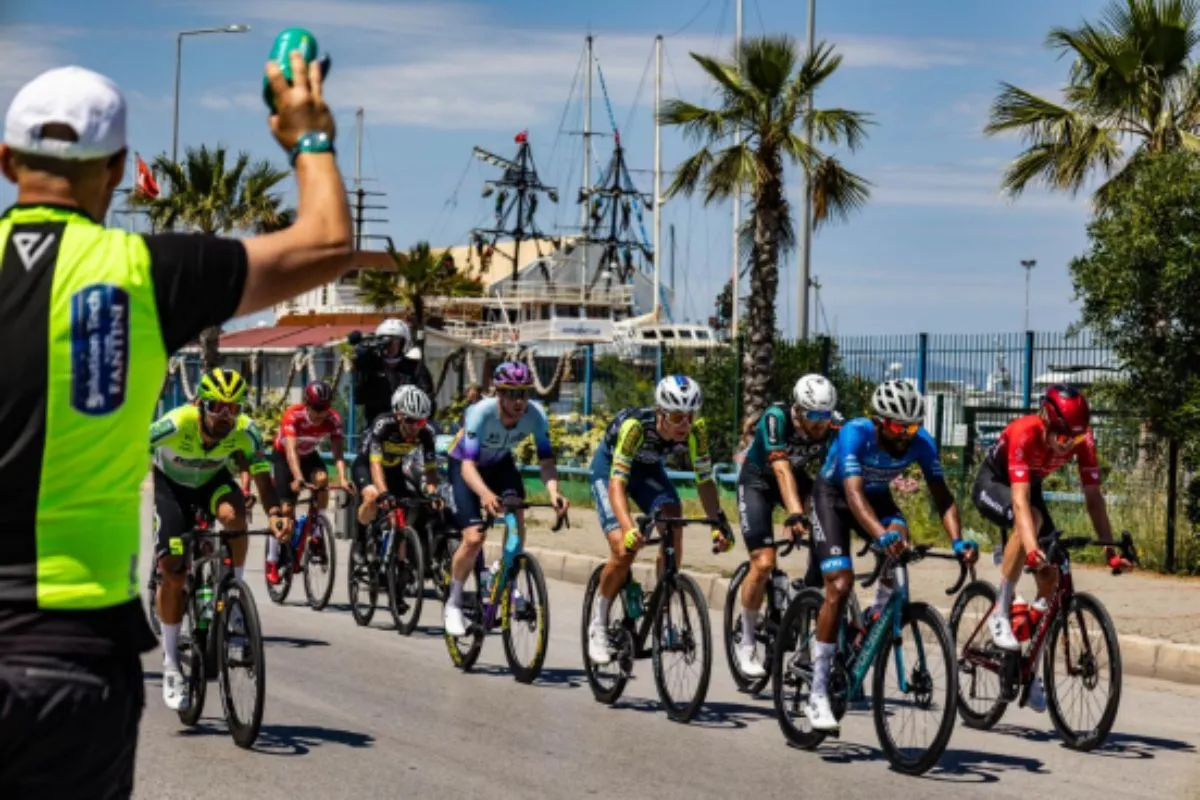
Electrolytes are minerals that dissociate into ions (charged particles) in body fluids.
Major ones relevant for cyclists include:
- Sodium (Na⁺): Primary extracellular cation, crucial for fluid balance, nerve conduction, and muscle activation.
- Potassium (K⁺): Intracellular cation, critical for repolarization of muscles and nerves.
- Magnesium (Mg²⁺): Supports ATP function, enzymatic reactions, muscle relaxation, and neuromuscular integrity.
- Calcium (Ca²⁺): Essential for muscle contraction, neuronal signaling, and bone health.
- Chloride (Cl⁻): Balances sodium to maintain osmotic pressure.
Sweat loses water and these electrolytes, with sodium being the most substantial loss. Sweat sodium varies significantly among athletes from ~10 to 70 mmol/L (≈230–1,610 mg/L). Sweat rate among cyclists under heat/intensity ranges 0.75 to 2 L/h, with 1 L/h being common. Typical sodium loss per hour can thus range from 575 to 1,725 mg; potassium losses are proportionately lower, around 155–200 mg/h.
Why Electrolytes Matter for Cycling Performance
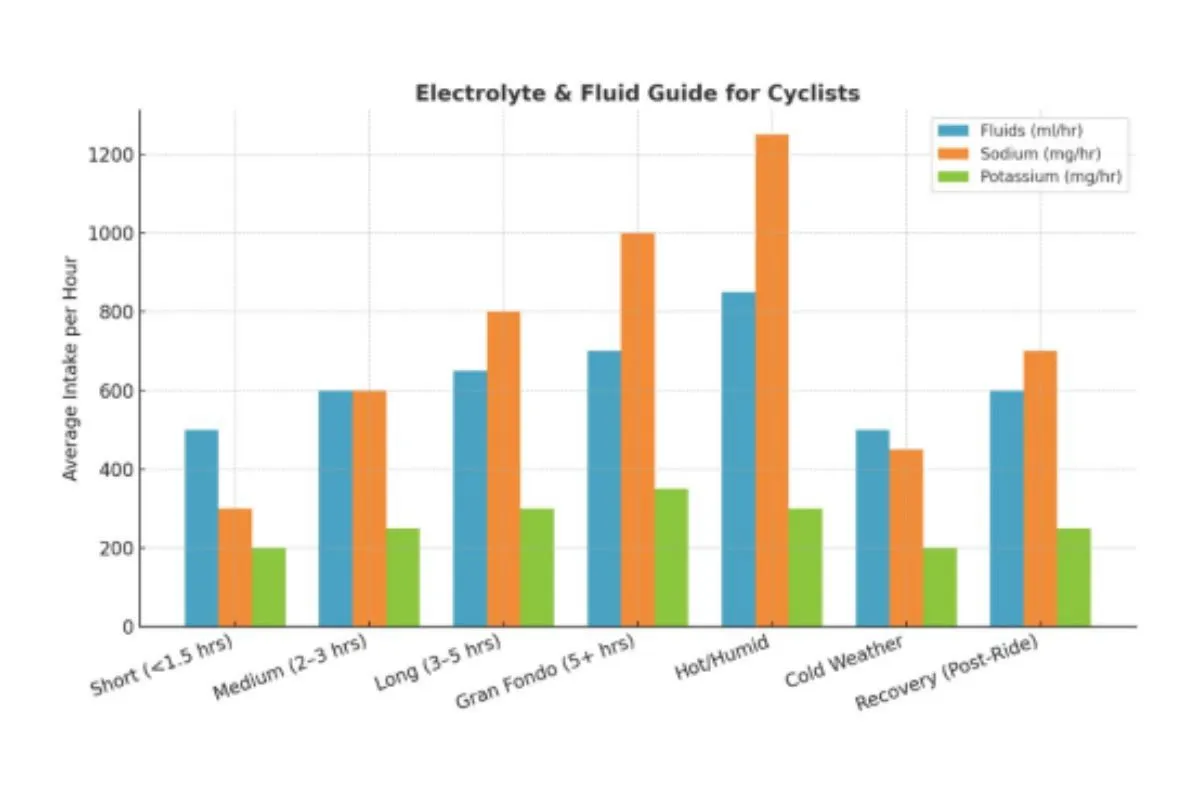
Every pedal stroke turns chemical energy into heat. In the 2024 European summer calendar, average race duration above thirty degrees Celsius heat-stress index rose by almost one fifth compared with 2018.
Hyponatremia still appears in up to one in eight finishers of mass-participation two-hundred-kilometre gravel events, and cramping remains the most common reason for a DNF in amateur ultra-distance racing.
Sodium, potassium, magnesium and calcium are the microscopic gatekeepers of blood volume, muscle contraction and nerve conduction; ignore them and watts evaporate long before glycogen runs out.
The Physiology in One Story
Picture the bloodstream as a pressurised hose.
Sodium keeps the hose full, potassium flicks the nozzle open and shut, magnesium releases the pressure when the job is done, and calcium is the spark that starts every squirt of water. Sweat leaks these valves onto the pavement.
Replace only water and the hose collapses; replace only sugar and the nozzle gums up. Replace the valves in their correct ratio and the hose delivers steady power for hours.
How Much Actually Leaves the Body
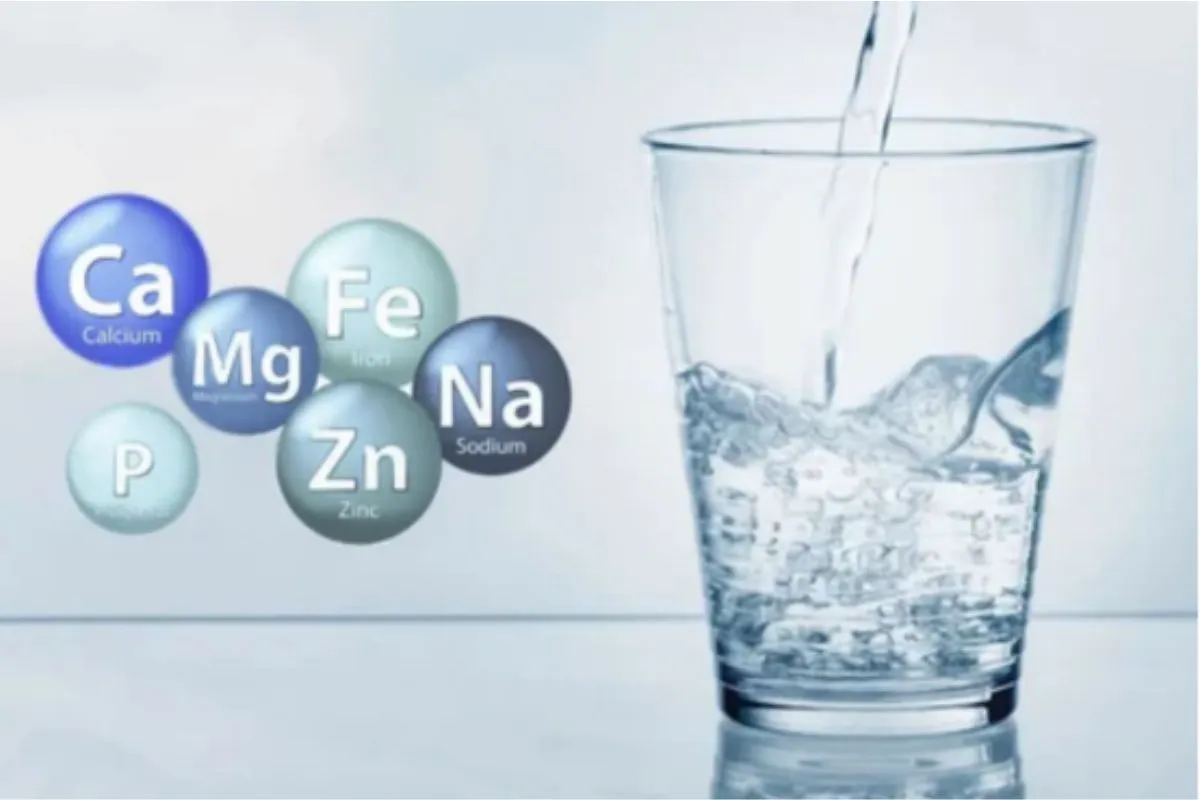
Laboratory sweat-patch data collected from more than 1200 cyclists show that sweat rate clusters around one litre per hour in temperate conditions but can exceed two litres per hour when the mercury climbs above thirty degrees.
Within that same litre, sodium concentration spans roughly 350 mg on the low end to well over 1500mg on the high end.
Two riders of equal weight, riding side by side at the same power, may differ by a factor of four in sodium loss.
Without measurement, blanket recommendations inevitably under-serve the heavy sweaters and over-serve the light ones.
Sodium: The Master Valve
Sodium governs plasma volume, blood pressure and the thirst reflex.
Every gram lost drags roughly thirty millilitres of water out of the vascular space.
A deficit of only 2% body mass in fluid often only 1.5 L reduces stroke volume, raises heart rate and increases the perceived effort of a sub-threshold interval by roughly 10%.
Replace sodium too slowly and the gut absorbs fluid poorly; replace it too aggressively and blood pressure climbs, the stomach rebels, and the kidneys simply dump the excess.
Potassium: The Quiet Rhythm Keeper
Potassium hides mostly inside the muscle cell. Sweat removes only a modest 150-200mg/L, yet the extracellular concentration is tightly guarded because the heart sets its pace to the ebb and flow of this ion.
Heavy supplementation during exercise is rarely necessary, but a diet chronically low in fruit, root vegetables and legumes can leave the myocardium irritable after 4 or 5 hours of steady sweating.
Magnesium: The Forgotten Relaxant
More than three hundred enzymatic reactions depend on magnesium, most notably the binding of adenosine triphosphate to its magnesium complex so that the energy molecule can release its phosphate group.
Sweat losses are small but cumulative, and deficiency shows first as eyelid twitches, then as calf cramps, and finally as an inexplicable rise in heart-rate drift.
Organic salts such as magnesium glycinate or citrate reach the bloodstream six to seven times more efficiently than cheap magnesium oxide.
Calcium: The Spark Plug
Calcium triggers every cross-bridge cycle in skeletal muscle and every beat of the heart. Sweat removes only trace amounts, yet long events can drain the free ion pool if dietary intake is marginal.
Dairy, fortified plant milks and leafy greens remain the simplest insurance policy.
Dose Response: Where the Curve Flattens
The best way to stay hydrated during the race is to drink regularly, but in small, manageable amounts. For races lasting more than an hour, athletes should aim to drink about 200-250ml of fluid every 15-20 minutes, depending on how much they sweat and how the weather affects fluid loss.

Controlled trials 35℃ heat show that riders consuming 500-700mg of sodium per hour lose only 2% of sub-maximal power after 4 hours, whereas riders taking 0mg sodium lose 12%. Push the dose above 900mg/h and power no longer improves; instead, nausea scores rise sharply and systolic blood pressure inches upward.
The practical ceiling for most athletes therefore lies between 570mg/, with outliers who truly excrete >60mmol/L justified in reaching900-1100mg/h.
The Risks of Not Replenishing
When sodium, potassium, magnesium and calcium are allowed to drift, the body moves through four escalating stages of failure.
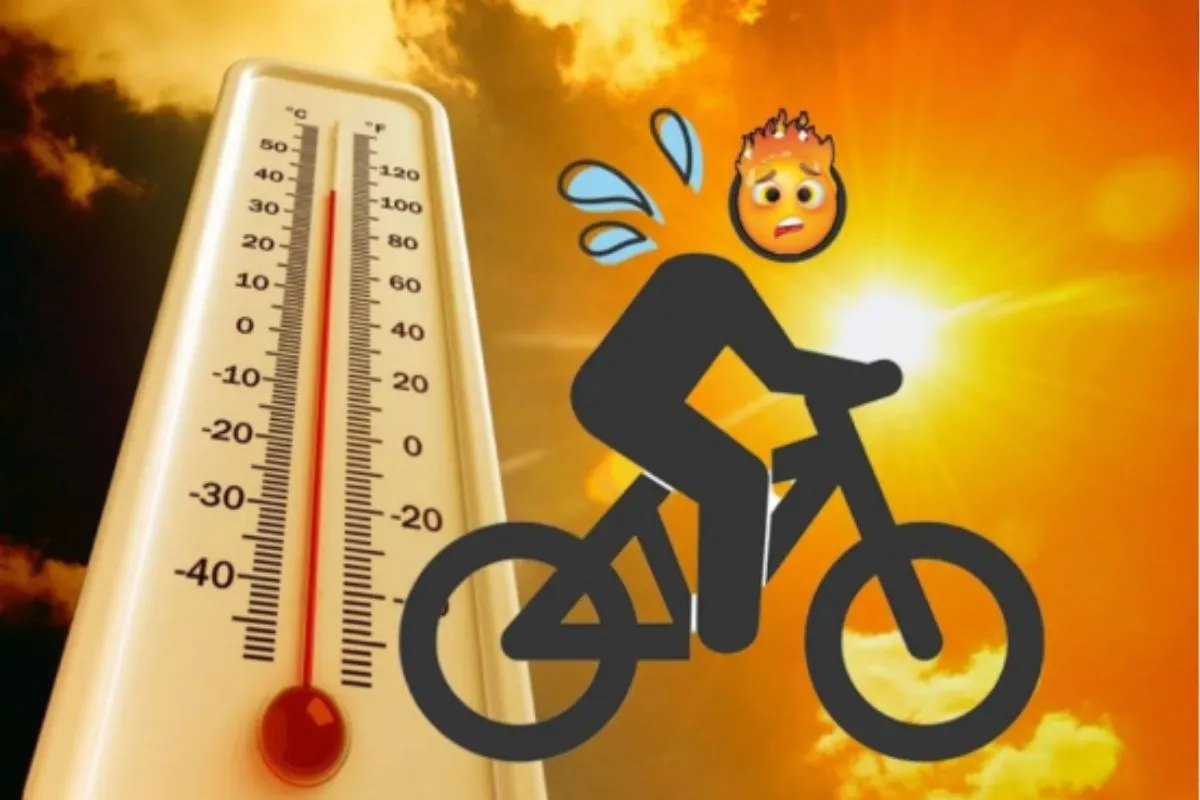
- Early dehydration within 30 – 60min shows as a five-to-ten-beat rise in heart rate for the same wattage and the first tick of thirst. Core temperature creeps upward because reduced plasma volume means reduced sweat rate. Legs feel wooden, yet the mind is still sharp.
- Neuromuscular misfirebetween 1-2 hrs appears as bilateral calf or hamstring twinges that no amount of stretching calms. The electrical signal that triggers each pedal stroke becomes erratic; shifting becomes clumsy and bottle grabs miss their mark. Fine motor control erodes, and the peloton suddenly feels threatening.
- Systemic breakdown after 2-4 hrsbrings magnesium-driven eyelid or diaphragm spasms and the sensation of skipped heartbeats. Cognitive fog sets in; missed turns, poor pack awareness and delayed reaction to road hazards follow. Power fades in surges and never fully returns.
- Critical collapse(>4 h) beyond four hours or during acute fluid overload presents as severe hyponatremia: pounding headache, nausea, swollen hands and face, confusion or slurred speech. If uncorrected, cerebral oedema, seizures and death can follow within hours. In parallel, calcium depletion can lock muscles in tetany, leading to rhabdomyolysis, myoglobin release and acute kidney injury.
The sequence is not theoretical. Post-race medical tents continue to see athletes wheeled in with plasma sodium below 130 millimoles per litre after replacing litres of plain water or low-sodium drink.
The corollary is clear: neglecting electrolytes does not merely slow you down it can end your race in an ambulance.
Pre-Ride Blueprint
- Arrive euhydrated: 2 hours pre-ride, 5–7 mL/kg fluid with 20 mg sodium/kg.
- Example for 70 kg rider: 500 mL water + 1.5 g salt + 40 g carbohydrate 90 min pre-rollout.
- Preloads plasma volume without sloshing in the gut.
Mid-Ride Protocol
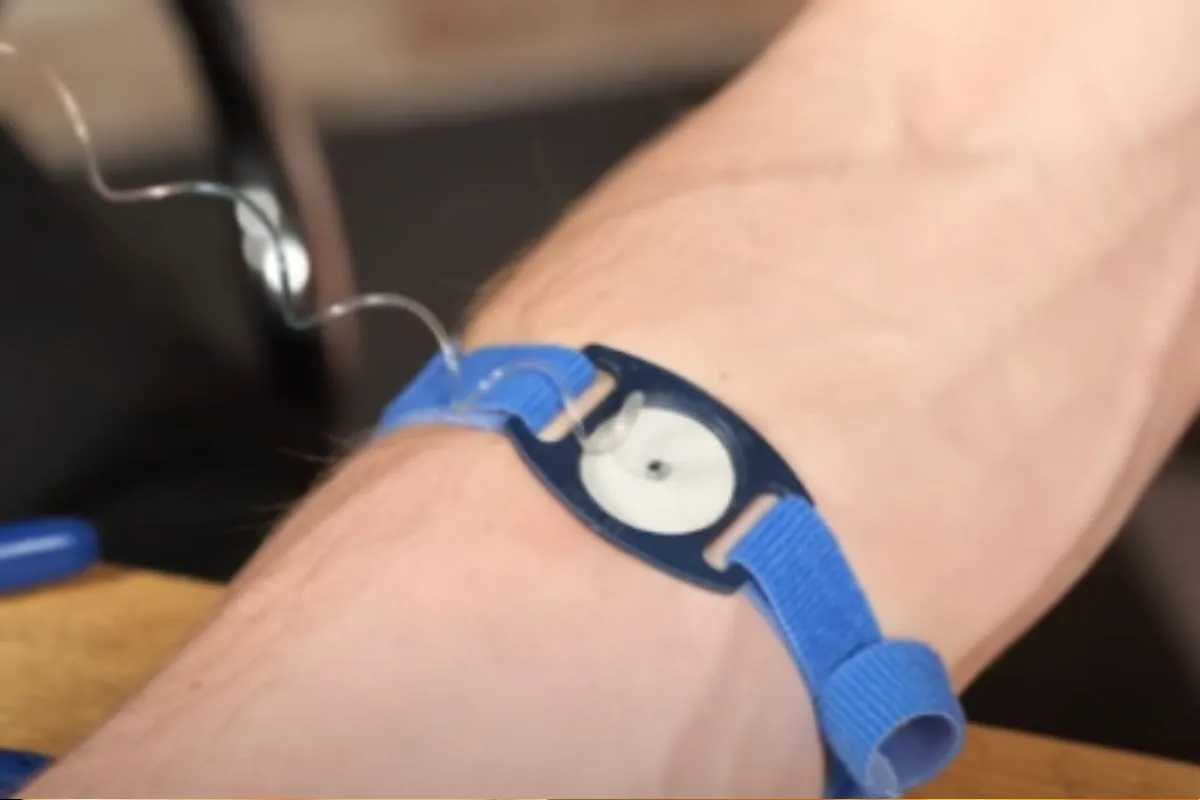
- Estimate sweat rate: 1-hour indoor trainer test at race pace in 28°C, no fan; 1 kg lost = 1 L sweat.
- Determine sodium target: Sweat-patch test if possible; otherwise 700 mg/L.
- Micro-dosing: Split hourly sodium target into 4–6 doses to stabilize plasma osmolality and prevent GI distress.
Post-Ride Recovery Arithmetic
- Replace 125–150% of fluid lostwithin 4 hours.
- Pair each liter with 1 g sodium, 1 g carbohydrate/kg body weight/hour for 2 hours, and 25 g protein to accelerate sodium-linked glucose transport and muscle repair.
Environmental & Genetic Modifiers
- Heat acclimation: 7–10 days reduces sweat sodium by ~33%.
- Altitude >2,000 m: Increases sweat rate; sodium concentration stable.
- Female riders, luteal phase:+15% sodium loss.
- Genetic variation (SCNN1B SNP):+40% sodium loss; simple cheek swab identifies carriers.
Tailor intake accordingly.
Cycling Electrolyte Strategies & Practical Hacks
Commercial & DIY Options
Commercial mixes: Light formulations for training, dual-carb blends for racing, zero-carb concentrates for flexibility.
Salt capsules: Simple and precise for targeted sodium dosing.
DIY isotonic example:
- 500 mL water
- ¼ tsp table salt (~600 mg sodium)
- 2 tsp sugar (~8 g carbohydrates)
- Squeeze of lemon for flavor
Quick Fixes for Common Symptoms

(Source: GCN)
- Side stitch (sudden): Often due to slow gastric emptying → switch to a 4% carbohydrate solution and sip smaller amounts.
- Headache with swollen fingers: Sign of dilutional hyponatremia → stop plain water, take one salt capsule, wait 3 minutes, then resume sipping at 150 mL/h.
- Bilateral calf cramps (resistant to stretching): Take 300 mg sodium + 200 mg magnesium glycinate within 10 minutes.
Emerging Technology
- Single-use sweat patches:Lab-grade sodium analysis in 15 minutes via smartphone.
- Bluetooth-enabled bottle caps:Remind riders if intake falls behind target.
- Wrist sensors for interstitial sodium:±3% accuracy; consumer release expected 2026.
Real-World Case Snapshots
2023 Vuelta Andalucía: 72 kg pro, sweat sodium 60 mmol/L, intake 980 mg/h → 1.5% weight loss, no cramps, finished 8th.
2024 Unbound Gravel 200: 85 kg amateur, intake 300 mg/h → cramped at km 160; sweat 68 mmol/L → under-replacement (~600 mg/h needed).
Medical Algorithm for Race Staff
- Green zone: <2% body weight loss, plasma sodium 135–145 mmol/L → maintain standard intake.
- Amber zone: 2–3% weight loss or plasma sodium 130–135 mmol/L → give 300 mg oral sodium, monitor closely.
- Red zone: Confusion, >3% loss, plasma sodium <130 mmol/L → IV 3% saline 100 mL bolus and immediate evacuation.
One-Page Top-Tube Quick Reference
- Pre-ride: Weigh nude; drink 5–7 mL/kg fluid with 20 mg sodium/kg ~90 min before start.
- During ride: Sip 150 mL every 10 minutes; target 500–700 mg sodium and 30–60 g carbohydrates per hour.
- Post-ride: Replace 125–150% of fluid lost; 1 g sodium/kg lost; 1.2 g carbohydrate/kg/hour for 2 hours.
- Visual cues: White crust on skin → 1 salt capsule; swollen fingers → stop water, take salt, wait before resuming.
Conclusion
Electrolytes are far more than a supplement they are the hidden engines that power every pedal stroke. Proper sodium, potassium, magnesium, and calcium balance supports hydration, neuromuscular function, and cognitive performance, protecting cyclists from cramps, fatigue, and life-threatening conditions like hyponatremia.
Replenishment is not one-size-fits-all: individual sweat rates, environmental conditions, genetics, and diet all influence needs. By testing sweat, dosing strategically, and adjusting for heat, altitude, and physiological differences, cyclists can maintain peak performance throughout training and racing.
In practice, the key principles are simple but powerful: test once, sip smart, dose small, finish strong. With the right strategy, the valves never run dry, and every ride whether training or racing can be executed safely, efficiently, and with maximum power output.



